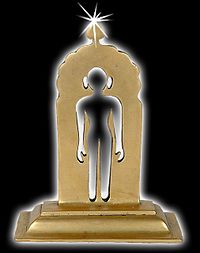Atma Siddhi
It is a composition of 142 verses in Gujarati, explaining the fundamental philosophical truths about the soul and its liberation.
The author, Shrimad Rajchandra, lays special emphasis on right perception (samyaktva), self-efforts and a true teacher's guidance on the path to self-realisation.
Although it is in poetry form, it is also known as Atma-siddhi Shastra as it enjoys a near-canonical status amongst the followers of Shrimad Rajchandra.
Atmasiddhi was composed by the nineteenth century Jain mystic poet Shrimad Rajchandra (1867–1901 C.E.).
[2] He is said to have experienced Jatismarana Jnana (knowledge of previous lives) at the age of seven years in 1874 CE while observing a dead body being cremated.
[3] Although he died at an age of 33 years, he produced a vast amount of spiritual literature in the forms of letters, poems and books.
Gandhi records in his autobiography that he was very impressed with him who answered his questions related to spirituality with patience and conviction.
In reply, Shrimad wrote the famous letter (also known as chha padno patra) dated 31-3-1888, propounding six fundamental truths, and inspired Lalluji Maharaj not to fear death.
They are worthy of being proved most effective and helpful to a soul very near to its liberation in his natural thinking and reflection.
These six steps are totally true or correct, beyond all possible doubt, and this is indicated by the very high person, Bhagawan Mahavira.
The discrimination of these six steps has been given by him to help a Jiva (Self) to rightly understand and realise his own forms and nature.
This direction of six steps is shown by all knowing great saints with a view to help a Jiva to shake-off its ego, developed by its suffering in its beginningless deluded state, and its strong feeling of mine and thine and so to be completely free from it.
If the Jiva realises that its real nature is free from this dream state, then in a moment it wakes up and achieves Samyak darshan or right vision or perception and attaining right vision, it can quickly obtain liberation as its own real nature.
Then it would not experience either joy or sorrow on account of contact with any perishable or impure object or bhava (passion.
[11][12] By propounding the six fundamental truths or steps, Shrimad basically summarized what ancient Jain philosophers had been saying in various texts.
Another great Jain monk Nemichandra says in his Dravyasamgraha:[14]The sentient substance (soul) is characterized by the function of understanding, is incorporeal, performs actions (doer), is co-extensive with its own body.
The discussion on the nature of the fundamental truth is in the form of a disciple's doubt and clarification given by the enlightened teacher.
Srimad notes that some people indulge simply in mindless rituals while others are only pedantic without any action—both believing theirs as the only true path.
Accordingly, neither the contemplation of self nor state of omniscience can be achieved without the existence of a true living guru.
This departs slightly with the traditional Jain belief (See Tattvarthasutra 1.3) that enlightenment can be achieved either through self on its own or through instrumentality of guru or scriptures.
[18] In Part II, the disciple expresses doubt on each of the six steps, which are answered by the enlightened teacher.
[27] The disciples doubt regarding self as the author of its actions (karma) and guru's explanation is discussed in verses 71 to 78.
[29] The verses 79 to 86 discuss the disciple's doubt on whether the soul itself is the enjoyer and sufferer of the consequences and the gurus clarification on the same.
Since, Karma fructifies on its own and passes away after it bears its consequences, necessity of God as dispenser of justice is done away with.
The path of liberation lies in destroying craving, aversion and ignorance, which are knots of karmic bondage.
Thus anyone who gives up strong opinions and viewpoints about various ideologies and follows the path enumerated above will attain liberation after a very few births.
Shri Atmasiddhishastra Rachnabhoomi is a memorial that stands at the site of the creation of Atmasiddhi Shastra in Nadiad.
[38] It has been restored by Shrimad Rajchandra Mission Dharampur preserving the original brick wall.



